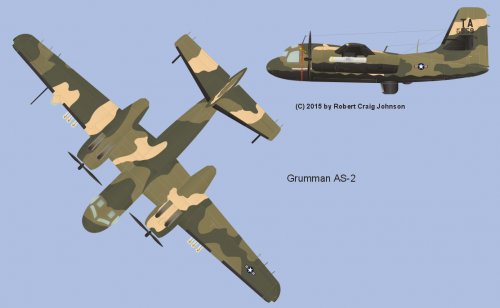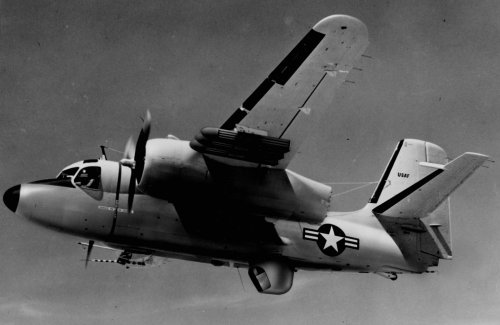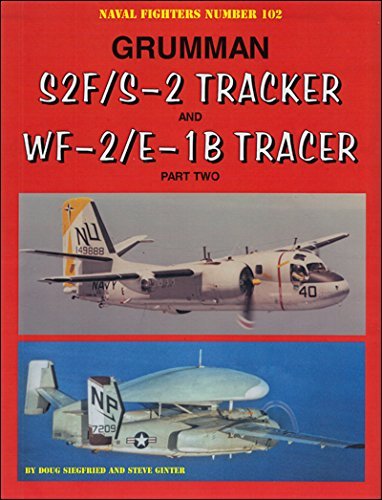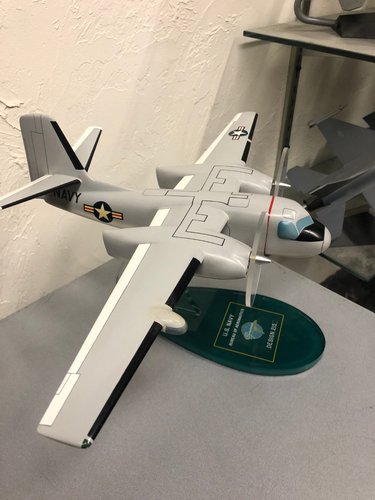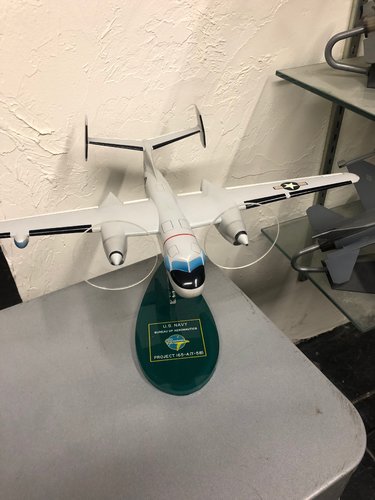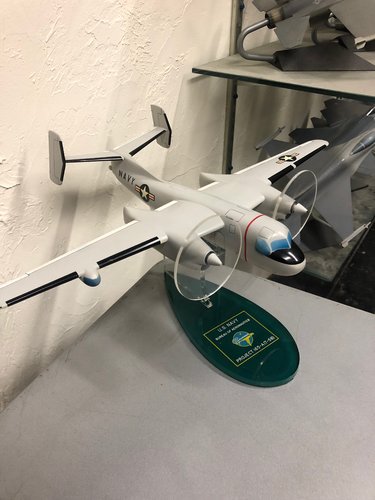You are using an out of date browser. It may not display this or other websites correctly.
You should upgrade or use an alternative browser.
You should upgrade or use an alternative browser.
- Joined
- 9 October 2009
- Messages
- 21,147
- Reaction score
- 12,248
On a side note, Design 215 was one of the projects cut in order to cover major Polaris program cost overruns.
Re: Grumman S2 Developments
Very cool, hesham, thanks for sharing. I have a weakness for the pudgy Grumman carrier-based patrol and cargo aircraft, and it's "déjà vu all over again" as Yogi Berra once said since the Navy was just recently in the position of choosing between upgrading their old C-2A Greyhounds or moving to a variant of the V-22 Osprey. Lockheed also pitched a COD conversion of mothballed S-3 Vikings at one point. Amazingly, they went with creeating a COD version of the Osprey for this role, which makes no sense at all to me for the very specialized COD mission. Still, the Greyhounds are great planes and I bet we'll be seeing Greyhound water bombers before long....
Very cool, hesham, thanks for sharing. I have a weakness for the pudgy Grumman carrier-based patrol and cargo aircraft, and it's "déjà vu all over again" as Yogi Berra once said since the Navy was just recently in the position of choosing between upgrading their old C-2A Greyhounds or moving to a variant of the V-22 Osprey. Lockheed also pitched a COD conversion of mothballed S-3 Vikings at one point. Amazingly, they went with creeating a COD version of the Osprey for this role, which makes no sense at all to me for the very specialized COD mission. Still, the Greyhounds are great planes and I bet we'll be seeing Greyhound water bombers before long....
In 1966, the USAF planned to convert S-2 aircraft into AS-2D interdiction aircraft that would attack truck traffic on the ho Chi Minh Trail in Laos, as part of Project Shed Light. These "Self-Contained Night Attack" (SNCA) aircraft would have detected their targets using Low Light Level TV (LLLTV), Forward Looking Infrared (FLIR), and the existing searchlight, cued by the LLLTV. They would have been fitted with crew armor and shielded exhausts and armed with standard bomblet dispensers: 10 SUU-24/A in the bomb bay and six SUU-14/A on the underwing racks. I seem to remember reading that the SUU-24/A dispensers were originally intended as a bomb-bay mounted dispenser for B-52s tasked with dispensing biological warfare bomblets. If so they were probably surplus to strategic requirements by 1966 and available for other uses.
The AS-2D program was eventually stopped due to lack of available aircraft and costs. Its intended role was eventually filled by the NC/AC-123 Black Spot--which demonstrated the ineffectiveness of the indiscriminate bomblet armament--and by the B-57G Tropic Moon III and the AC-130 gunships.
See the sources listed for sketches of the bomb-bay installation and crew armor.
I've attached a speculative drawing that shows the FLIR/LLLTV mounted in a turret that replaces the retractable S-2 radar. Given the bulk of the equipment that went into the B-57G nose, the lack of space in the S-2 nose, and likely center-of-gravity issues, this seemed reasonable. But the draawings I have seen only show the bomb bay and crew armor. So, if anyone knows the actual intended configuration, I'd like to hear about it.
Sources:

 forums.spacebattles.com
forums.spacebattles.com

 en.wikipedia.org
en.wikipedia.org
The AS-2D program was eventually stopped due to lack of available aircraft and costs. Its intended role was eventually filled by the NC/AC-123 Black Spot--which demonstrated the ineffectiveness of the indiscriminate bomblet armament--and by the B-57G Tropic Moon III and the AC-130 gunships.
See the sources listed for sketches of the bomb-bay installation and crew armor.
I've attached a speculative drawing that shows the FLIR/LLLTV mounted in a turret that replaces the retractable S-2 radar. Given the bulk of the equipment that went into the B-57G nose, the lack of space in the S-2 nose, and likely center-of-gravity issues, this seemed reasonable. But the draawings I have seen only show the bomb bay and crew armor. So, if anyone knows the actual intended configuration, I'd like to hear about it.
Sources:
US Air Force wanted to turn Navy sub-hunters into attack aircraft
AS-2D would have sprinkled thousands of tiny bombs across Vietnam In 1968, the U.S. Air Force canceled a program to convert old Navy submarine hunters into attack aircraft. The flying branch had spent two years trying to get the planes ready for Vietnam. The project was part of a larger...

Operation Shed Light - Wikipedia
Attachments
Very interesting, iverson, thanks for sharing. Was that the same program that led to the YOV-10D NOGS with the 20mm belly turret?
Tailspin Turtle said:Grumman Design 436: Demonstrator was to have an AN/APQ-115 Radar for automatic terrain clearance in the nose, which was extended 24", and a Low-Light-Level TV installed in place of the dustbin radar. MTI radar and FLIR were postulated.
Thanks!
cluttonfred said:Very interesting, iverson, thanks for sharing. Was that the same program that led to the YOV-10D NOGS with the 20mm belly turret?
No, the YOV-10D was a later project. The OV-10A was initially considered for the AS-2D role, but could not carry all of the electronics.
- Joined
- 26 May 2006
- Messages
- 33,550
- Reaction score
- 13,648
Tailspin Turtle said:Grumman Design 436: Demonstrator was to have an AN/APQ-115 Radar for automatic terrain clearance in the nose, which was extended 24", and a Low-Light-Level TV installed in place of the dustbin radar. MTI radar and FLIR were postulated.
Thank you my dear Tailspin.
- Joined
- 26 September 2008
- Messages
- 1,935
- Reaction score
- 680
Grumman S2F/S-2 Tracker and WF-2/E-1B Tracer Part Two (Naval Fighters): Ginter, Steve, Siegfried, Douglas: 9780996825832: Amazon.com: Books
Grumman S2F/S-2 Tracker and WF-2/E-1B Tracer Part Two (Naval Fighters) [Ginter, Steve, Siegfried, Douglas] on Amazon.com. *FREE* shipping on qualifying offers. Grumman S2F/S-2 Tracker and WF-2/E-1B Tracer Part Two (Naval Fighters)
www.amazon.com
Attachments
- Joined
- 11 March 2011
- Messages
- 296
- Reaction score
- 1,091
I'll rekindle this conversation with pictures of 2 recently acquired in-house wood S-2 models that I was lucky to find. Enjoy......
Attachments
So what were the engine options being proposed on the above. One implies T58 but what about the other?
- Joined
- 19 February 2007
- Messages
- 1,287
- Reaction score
- 2,186
Allyson, I think the models and bases were inadvertently swapped. I have notes indicating:
G-165 Twinned T53 proposal
G-215 T64 Testbed
Here is a rough comparison of how the various engine options would stack up:
These are rough numbers. What is not known is how much additional fuel would be required to support the increased fuel consumption of the turboshaft engines and how that would offset the lighter powerplant weights. Grumman would be well aware of T53 details as that was the powerplant for the AO-1 (OV-1) Mohawk then under development.
While the T53 was never "twinned" the later PWC PT6 was, as the PT-6T and has had a long and successful history in the Bell 212/UH-1N family among others.
G-165 Twinned T53 proposal
G-215 T64 Testbed
Here is a rough comparison of how the various engine options would stack up:
| Aircraft | Engine | Approximate Power | Approx. Powerplant Weight |
|---|---|---|---|
| S-2F | R1820 | 1,525hp | 1184lb engine weight |
| G-165 | T53 | 860hp - approx 1,700hp in twin install. | approx 400lb engine weight and 900 to 1,000lb weight (including combining gearbox) in twin install |
| G-215 | T64 | 3,080hp | approx 720lb engine weight |
| G-215A | T58 | 1,300hp | approx 400lb engine weight |
These are rough numbers. What is not known is how much additional fuel would be required to support the increased fuel consumption of the turboshaft engines and how that would offset the lighter powerplant weights. Grumman would be well aware of T53 details as that was the powerplant for the AO-1 (OV-1) Mohawk then under development.
While the T53 was never "twinned" the later PWC PT6 was, as the PT-6T and has had a long and successful history in the Bell 212/UH-1N family among others.
- Joined
- 11 March 2011
- Messages
- 296
- Reaction score
- 1,091
Hey Craig, thanks for the heads up. These picts were done when I took the models from my suitcase and had the wrong stands.... switched them before they were put on the shelves... Thanks. You doing OK I hope. Sir George says you are going for a visit. Have a blast will you? He has the most comfortable bed in Europe.
D
Deleted member 2278
Guest
Irish S-2 Tracker for offshore patrol:
- Joined
- 9 October 2009
- Messages
- 21,147
- Reaction score
- 12,248
Interesting that they were planning to have Aer Rianta operate them in the Fishery Protection/maritime restricted zone (nowadays EEZ) patrol role rather than the Air Corps. The fact that the traditionally anti-military Labour party was still in power in early 1977 as a part of the then Fine Gael-Labour coalition government (which would come to an unexpected end in an election later that year) may explain that at least in part.
Last edited:
D
Deleted member 2278
Guest
Philippine RFI on S-2Gs:
D
Deleted member 2278
Guest
A bit more on the non-availability of P-3s and the suggestion of S-2Gs for the Philippines here:
After long and arduous research I have found bit of proof that France considered the Tracker AEW (that is: E-1B Tracer, also known as Stoof-with-a-roof) twice, at the beginning and at the end of the Clemenceaus lives: in 1963 and 1993 respectively... in the end, CdG got E-2C and soon, E-2D.
- Joined
- 21 May 2006
- Messages
- 2,833
- Reaction score
- 1,915
Please tell us more ArchibaldAfter long and arduous research I have found bit of proof that France considered the Tracker AEW (that is: E-1B Tracer, also known as Stoof-with-a-roof) twice, at the beginning and at the end of the Clemenceaus lives: in 1963 and 1993 respectively... in the end, CdG got E-2C and soon, E-2D.
Regards
Pioneer
Aeroweanie
ACCESS: Confidential
- Joined
- 1 May 2020
- Messages
- 70
- Reaction score
- 191
This program involving C-1s is still ongoing:
 www.prnewswire.com
www.prnewswire.com

Elbit Systems U.S. Subsidiary Awarded $106 Million Contract for the Upgrade of C-1A Aircraft for the Brazilian Navy
/PRNewswire/ -- Elbit Systems Ltd. (NASDAQ and TASE:ESLT) ("Elbit Systems") announced today that its wholly-owned U.S. subsidiary, Elbit Systems of America,...
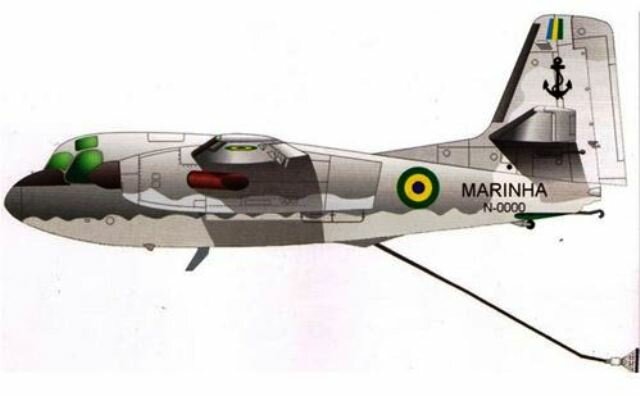
- Joined
- 11 March 2012
- Messages
- 3,119
- Reaction score
- 2,955
CV-22 Osprey may not be the best airframe for the COD mission, but it is in production and in service and eliminates the need to devote billions of dollars to a short production run of specialized COD airframes.Re: Grumman S2 Developments
Very cool, hesham, thanks for sharing. I have a weakness for the pudgy Grumman carrier-based patrol and cargo aircraft, and it's "déjà vu all over again" as Yogi Berra once said since the Navy was just recently in the position of choosing between upgrading their old C-2A Greyhounds or moving to a variant of the V-22 Osprey. Lockheed also pitched a COD conversion of mothballed S-3 Vikings at one point. Amazingly, they went with creeating a COD version of the Osprey for this role, which makes no sense at all to me for the very specialized COD mission. Still, the Greyhounds are great planes and I bet we'll be seeing Greyhound water bombers before long....
- Joined
- 11 March 2012
- Messages
- 3,119
- Reaction score
- 2,955
Twinned Pratt and Whitney of Canada PT6A engines were never installed in Trackers. Twinned PT6A engines are limited to helicopters.Allyson, I think the models and bases were inadvertently swapped. I have notes indicating:
G-165 Twinned T53 proposal
G-215 T64 Testbed
Here is a rough comparison of how the various engine options would stack up:
Aircraft Engine Approximate Power Approx. Powerplant Weight S-2F R1820 1,525hp 1184lb engine weight G-165 T53 860hp
- approx 1,700hp in twin install.approx 400lb engine weight
and 900 to 1,000lb weight (including combining gearbox) in twin installG-215 T64 3,080hp approx 720lb engine weight G-215A T58 1,300hp approx 400lb engine weight
These are rough numbers. What is not known is how much additional fuel would be required to support the increased fuel consumption of the turboshaft engines and how that would offset the lighter powerplant weights. Grumman would be well aware of T53 details as that was the powerplant for the AO-1 (OV-1) Mohawk then under development.
While the T53 was never "twinned" the later PWC PT6 was, as the PT-6T and has had a long and successful history in the Bell 212/UH-1N family among others.
However, Conair converted Turbo Fire Cats are powered by single P&WC PT6A-67AF turbo-prop engines producing 1,220 horsepower per side. They spin 5-bladed propellers. Conair conversions are mainly used for fire-fighting.
Meanwhile Marsh Aviation installs Garret TPE331 engines in their S-2F3AT Turbo Tracker conversions. They make 531 to 940 horsepower depending upon the dash number. Marsh conversions sold to the Brazilian Navy and several civilian forest fire-fighting organizations.
- Joined
- 8 January 2006
- Messages
- 1,605
- Reaction score
- 730
What Riggerbob said. The configuration of the PT6T would be quite unsuitable for an aircraft other than helicopters as it presents some unique problems whether installed for a tractor prop or a pusher prop. I won't say it can't be done, but it makes for some "interesting" design choices.Twinned Pratt and Whitney of Canada PT6A engines were never installed in Trackers. Twinned PT6A engines are limited to helicopters.Allyson, I think the models and bases were inadvertently swapped. I have notes indicating:
G-165 Twinned T53 proposal
G-215 T64 Testbed
Here is a rough comparison of how the various engine options would stack up:
Aircraft Engine Approximate Power Approx. Powerplant Weight S-2F R1820 1,525hp 1184lb engine weight G-165 T53 860hp
- approx 1,700hp in twin install.approx 400lb engine weight
and 900 to 1,000lb weight (including combining gearbox) in twin installG-215 T64 3,080hp approx 720lb engine weight G-215A T58 1,300hp approx 400lb engine weight
These are rough numbers. What is not known is how much additional fuel would be required to support the increased fuel consumption of the turboshaft engines and how that would offset the lighter powerplant weights. Grumman would be well aware of T53 details as that was the powerplant for the AO-1 (OV-1) Mohawk then under development.
While the T53 was never "twinned" the later PWC PT6 was, as the PT-6T and has had a long and successful history in the Bell 212/UH-1N family among others.
However, Conair converted Turbo Fire Cats are powered by single P&WC PT6A-67AF turbo-prop engines producing 1,220 horsepower per side. They spin 5-bladed propellers. Conair conversions are mainly used for fire-fighting.
Meanwhile Marsh Aviation installs Garret TPE331 engines in their S-2F3AT Turbo Tracker conversions. They make 531 to 940 horsepower depending upon the dash number. Marsh conversions sold to the Brazilian Navy and several civilian forest fire-fighting organizations.
- Joined
- 11 March 2012
- Messages
- 3,119
- Reaction score
- 2,955
Soloy of Olympia, Washington State did experiment with installing PT6A Twin-Pacs in prop-driven airplanes. They test-flew a DHC-3 Otter and Cessna 208 Caravan with PT6A Twin-Pac, but the FAA imposed too many restrictions on single-props carrying passengers so the project never entered production.What Riggerbob said. The configuration of the PT6T would be quite unsuitable for an aircraft other than helicopters as it presents some unique problems whether installed for a tractor prop or a pusher prop. I won't say it can't be done, but it makes for some "interesting" design choices.Twinned Pratt and Whitney of Canada PT6A engines were never installed in Trackers. Twinned PT6A engines are limited to helicopters.Allyson, I think the models and bases were inadvertently swapped. I have notes indicating:
G-165 Twinned T53 proposal
G-215 T64 Testbed
Here is a rough comparison of how the various engine options would stack up:
Aircraft Engine Approximate Power Approx. Powerplant Weight S-2F R1820 1,525hp 1184lb engine weight G-165 T53 860hp
- approx 1,700hp in twin install.approx 400lb engine weight
and 900 to 1,000lb weight (including combining gearbox) in twin installG-215 T64 3,080hp approx 720lb engine weight G-215A T58 1,300hp approx 400lb engine weight
These are rough numbers. What is not known is how much additional fuel would be required to support the increased fuel consumption of the turboshaft engines and how that would offset the lighter powerplant weights. Grumman would be well aware of T53 details as that was the powerplant for the AO-1 (OV-1) Mohawk then under development.
While the T53 was never "twinned" the later PWC PT6 was, as the PT-6T and has had a long and successful history in the Bell 212/UH-1N family among others.
However, Conair converted Turbo Fire Cats are powered by single P&WC PT6A-67AF turbo-prop engines producing 1,220 horsepower per side. They spin 5-bladed propellers. Conair conversions are mainly used for fire-fighting.
Meanwhile Marsh Aviation installs Garret TPE331 engines in their S-2F3AT Turbo Tracker conversions. They make 531 to 940 horsepower depending upon the dash number. Marsh conversions sold to the Brazilian Navy and several civilian forest fire-fighting organizations.
The Cessna Caravan conversion had a stock forward fuselage with a bulged engine cowling to accommodate the two engines. They drove a single propeller through a combining gearbox. The aft fuselage was extended (ala. Grand Caravan) for balance.
BlackBat242
OK, I changed my personal text ;)
- Joined
- 10 April 2013
- Messages
- 1,204
- Reaction score
- 3,298
Re: Grumman S2 Developments
Very cool, hesham, thanks for sharing. I have a weakness for the pudgy Grumman carrier-based patrol and cargo aircraft, and it's "déjà vu all over again" as Yogi Berra once said since the Navy was just recently in the position of choosing between upgrading their old C-2A Greyhounds or moving to a variant of the V-22 Osprey. Lockheed also pitched a COD conversion of mothballed S-3 Vikings at one point. Amazingly, they went with creeating a COD version of the Osprey for this role, which makes no sense at all to me for the very specialized COD mission. Still, the Greyhounds are great planes and I bet we'll be seeing Greyhound water bombers before long....
CV-22 Osprey may not be the best airframe for the COD mission, but it is in production and in service and eliminates the need to devote billions of dollars to a short production run of specialized COD airframes.
While I don't necessarily agree with the decision, I can see some logic behind the choice.
For decades the USN has used C-2s to fly material & personnel to/from carriers, and a CH-46 on supply ships to carry sling-loads and internal loads to LHA/LHD/LPD/LSDs as well as to destroyers etc.
Sometimes this has required flying supplies onto a carrier, transferring them to a helo, then flying them to the intended recipient ship.
With the CMV-22B the USN can fly supplies to/from carriers and then to/from other ships without needing to move them to another aircraft.
This not only simplifies the delivery end, it eliminates one aircraft type (while the USN has used SH-60s for the job it takes 2-3 trips to move what one CH-46 could carry on one trip. If the Osprey had not been selected, then either a more-capable cargo helo or extra SH-60s would have needed to be purchased, and the need to transfer between aircraft (and sometimes to re-pack in a different set-up) would still exist.
Similar threads
-
Grumman / Shin Meiwa PX-2 Flying boat.
- Started by Pioneer
- Replies: 5
-
-
Grumman Design 118 (not the XF12F!)
- Started by overscan (PaulMM)
- Replies: 34
-
-



